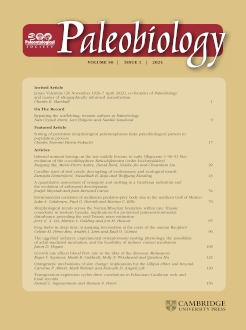Conodonts were marine vertebrates with tooth-like structures that are commonly preserved in the fossil record. The Late Triassic conodont species Mockina ex gr. carinata and Mockina ex gr. englandi were exceptionally prevalent among marine animals from the middle Norian through to the Rhaetian stages of geologic time. Leading into the complete extinction of conodonts near the Triassic/Jurassic boundary, a significant change in conodont forms occurred across the Norian/Rhaetian boundary (NRB), with the common Rhaetian varieties from Europe exhibiting thinner shapes. This trend is not as evident in North America, where these varieties are very rare, but analyses on M. ex gr. carinata and M. ex gr. englandi specimens from across western Canadian demonstrate that comparable shifts in form occurred in North America across the NRB, confirming the global extent of these trends. The specimens of M. ex gr. carinata display a sequential width reduction from the middle Norian to late Norian to Rhaetian, whereas the specimens of M. ex gr. englandi display a width reduction only from the late Norian to Rhaetian. Specimens of both species that have a length to mid-breadth ratio greater than 3:1 are restricted to the Rhaetian. Specimens from the Kennecott Point section on Haida Gwaii, British Columbia, demonstrate that this shift in form occurred somewhat later than other events and changes associated with the NRB. The global trend of width reduction in many conodonts may reflect a change in diet away from hard food sources, perhaps suggesting some degree of pressure on the biological precipitation of minerals beginning around the NRB. This interpretation would support CO2 release as the causal mechanism of the environmental disturbance at the NRB and identify the NRB as a significant turning point for Late Triassic ecosystems, marking the beginning of a protracted, multiphase end-Triassic mass extinction.
The Late Triassic conodont species Mockina ex gr. carinata and Mockina ex gr. englandi were exceptionally prevalent among the marine fauna of the Panthalassan realm from the middle Norian through to the Rhaetian. Leading into the complete extinction of conodonts near the Triassic/Jurassic boundary, a significant turnover event occurred in conodont fauna across the Norian/Rhaetian boundary (NRB), with the pectiniform elements of common Rhaetian genera from Tethys exhibiting minimal or absent platforms. This intergeneric trend of platform reduction is not as evident in Panthalassa, where these genera are very rare, but morphometric analyses of M. ex gr. carinata and M. ex gr. englandi specimens from across the Canadian Cordillera demonstrate that comparable shifts in morphology occurred intraspecifically in Panthalassa across the NRB, confirming the global extent of these trends. Pectiniform elements of M. ex gr. carinata display a sequential reduction of platform width from the middle Norian to late Norian to Rhaetian, whereas pectiniform elements of M. ex gr. englandi display a reduction of platform width only from the late Norian to Rhaetian. Specimens of both species that have a mid-platform length to breadth ratio greater than 3:1 are restricted to the Rhaetian. Specimens from the Kennecott Point section on Haida Gwaii, British Columbia, demonstrate that this morphological shift occurred somewhat later than other biostratigraphic proxies for the NRB. The global trend of platform width reduction in many conodont pectiniform elements may reflect a change in primary diet away from hard food sources, perhaps suggesting some degree of carbonate biomineralization suppression beginning around the NRB. This interpretation would support CO2 outgassing as the causal mechanism of the environmental disturbance at the NRB and identify the NRB as a significant turning point for Late Triassic ecosystems, marking the beginning of a protracted, multiphase end-Triassic mass extinction.






